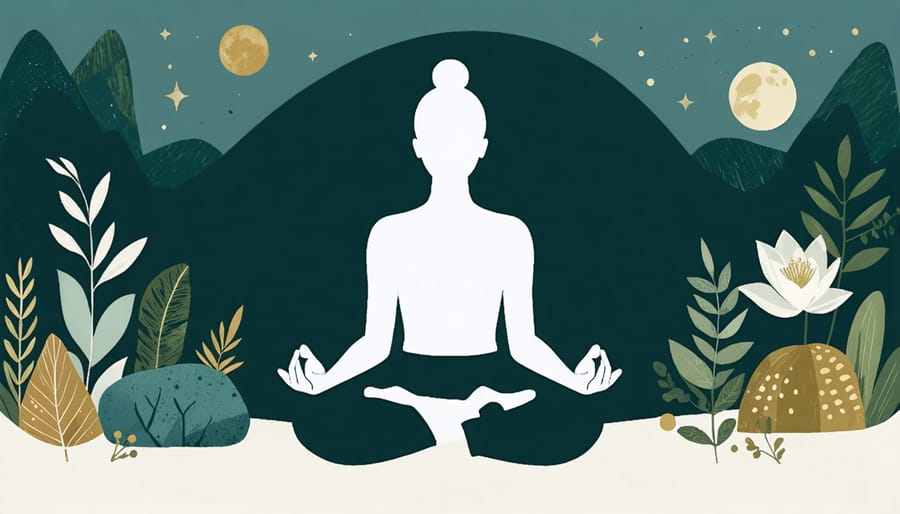
Transform your life by understanding wellness as a harmonious symphony of six essential dimensions. Beyond the basic concept of health, true well-being emerges when we actively nourish your mind, body and soul through multiple interconnected aspects of life. Physical vitality, emotional balance, social connections, spiritual growth, intellectual stimulation, and occupational fulfillment work together to create a foundation for lasting happiness and fulfillment.
Think of these dimensions as the pillars supporting your personal wellness temple – when one weakens, the entire structure feels the impact. Whether you’re thriving in your career but neglecting social connections, or maintaining perfect physical health while struggling emotionally, true wellness requires attention to all six areas. By understanding and nurturing each dimension, you’ll discover a more balanced, purposeful, and joy-filled life.
Let’s explore how these dimensions interact and learn practical strategies to enhance each area, creating a life that feels not just healthy, but truly whole and harmonious. Your journey to complete wellness starts with acknowledging these interconnected aspects of your well-being and taking mindful steps to strengthen each one.

Physical Wellness: Nourishing Your Body Inside and Out
Clean Beauty and Natural Self-Care
Your beauty routine isn’t just about looking good – it’s an act of self-care that nurtures both body and soul. Clean beauty, focusing on natural and non-toxic ingredients, has revolutionized how we approach skincare and personal care. As someone who struggled with sensitive skin for years, I’ve learned that what we put on our bodies is just as important as what we put in them.
Start by reading ingredient labels and choosing products with recognizable, plant-based components. Consider incorporating items like pure coconut oil as a makeup remover, raw honey as a gentle cleanser, or green tea-infused toners into your routine. These natural alternatives often provide multiple benefits while being gentle on your skin and the environment.
Creating a mindful beauty ritual can be as simple as taking five extra minutes to massage your face while applying moisturizer or practicing deep breathing during your evening skincare routine. Try making your own DIY masks using kitchen ingredients like avocado, yogurt, or oatmeal – it’s not only cost-effective but also gives you complete control over what you’re putting on your skin.
Remember, clean beauty isn’t about perfection; it’s about making conscious choices that align with your wellness goals and values.
Wholesome Nutrition
Nourishing your body isn’t just about counting calories or following the latest diet trends – it’s about creating a sustainable, enjoyable relationship with food that energizes and supports your overall well-being. As someone who’s journeyed through various eating philosophies, I’ve learned that the key lies in developing mindful eating practices that honor both your body’s needs and your emotional connection with food.
Focus on incorporating a rainbow of whole foods into your meals, including plenty of fresh vegetables, fruits, lean proteins, and wholesome grains. Think of your plate as an artist’s palette – the more colors you include, the more nutrients you’re getting! Start small by adding an extra serving of vegetables to your dinner or swapping processed snacks for nutrient-dense alternatives like nuts, seeds, or fresh fruit.
Remember, wholesome nutrition isn’t about perfection – it’s about progress and balance. Listen to your body’s hunger and fullness cues, savor each bite, and allow yourself to enjoy occasional treats without guilt. The goal is to create a positive, sustainable approach to eating that nourishes both body and soul.
Emotional Wellness: Building Inner Resilience
I remember sitting in my garden one evening, overwhelmed by a particularly challenging day, when I realized that emotional wellness isn’t just about being happy—it’s about developing a deep understanding of our feelings and learning to navigate them skillfully. Building emotional resilience is like tending to an inner garden; it requires patience, dedication, and the right tools.
At its core, emotional wellness involves recognizing and accepting our feelings without judgment. Think of it as becoming your own emotional detective, carefully observing your reactions and patterns. When was the last time you paused to really check in with yourself?
One powerful way to enhance emotional wellness is through daily mindfulness practices. These don’t have to be complicated—even five minutes of deep breathing during your morning coffee can make a difference. I’ve found that keeping a mood journal helps track emotional patterns and triggers, making it easier to respond rather than react to challenging situations.
Stress reduction is another crucial aspect of emotional wellness. Try the 5-4-3-2-1 grounding technique when feeling overwhelmed: identify five things you can see, four things you can touch, three things you can hear, two things you can smell, and one thing you can taste. This simple exercise can help anchor you in the present moment.
Creating healthy emotional boundaries is equally important. It’s okay to say no, to take time for yourself, and to prioritize your emotional well-being. Think of boundaries as invisible force fields that protect your energy and help maintain your emotional balance.
Remember, emotional wellness isn’t about eliminating negative emotions—it’s about developing a healthy relationship with all your feelings. Some days will be harder than others, and that’s perfectly normal. The goal is to build a sturdy emotional foundation that can weather life’s inevitable storms while maintaining your sense of inner peace and authenticity.
Social Wellness: Cultivating Meaningful Connections
In our increasingly digital world, nurturing meaningful connections has become more important than ever for our overall well-being. Social wellness encompasses our ability to build and maintain healthy relationships, engage with our community, and create a strong support network that enriches our lives.
I remember when I first moved to a new city, feeling disconnected and isolated. It wasn’t until I joined a local book club that I discovered the transformative power of genuine social connections. Like tending to a garden, our relationships require consistent care, attention, and nurturing to flourish.
Building social wellness starts with cultivating authentic relationships. This means moving beyond surface-level interactions to create deeper, more meaningful connections. Practice active listening during conversations, show genuine interest in others’ lives, and be vulnerable enough to share your own experiences. These small acts build trust and strengthen bonds over time.
Community engagement plays a vital role in social wellness. Whether it’s volunteering at a local shelter, participating in neighborhood events, or joining groups that share your interests, these activities create a sense of belonging and purpose. They also expand your social circle and expose you to diverse perspectives and experiences.
Don’t forget about maintaining boundaries and recognizing toxic relationships. Healthy social wellness means surrounding yourself with people who uplift and support you while respectfully distancing yourself from relationships that drain your energy.
Remember, quality matters more than quantity when it comes to relationships. Focus on nurturing connections that bring joy, support, and meaning to your life, whether that’s with family, friends, or community members. Even small social interactions, like chatting with your barista or greeting neighbors, can contribute to your overall social well-being.

Intellectual Wellness: Feeding Your Mind
Think of your mind as a garden – it needs regular nurturing to flourish. Intellectual wellness isn’t just about academic achievements; it’s about maintaining a curious and engaged mind that continues to grow throughout your life. I remember when I first started practicing daily reading before bed instead of scrolling through social media – the difference in my mental clarity and creativity was remarkable!
Feeding your mind doesn’t require a formal classroom setting. It can be as simple as diving into a new podcast series, joining a book club, or learning to play that instrument you’ve always dreamed about. The key is to find learning opportunities that genuinely excite you. Whether it’s mastering a new language through a mobile app or taking an online course in photography, choose activities that spark joy and challenge your thinking.
Creative expression is another vital aspect of intellectual wellness. Try journaling, painting, or even cooking new recipes – these activities engage different parts of your brain and help maintain cognitive flexibility. I’ve found that setting aside just 30 minutes a day for creative pursuits has helped me stay mentally sharp and more innovative in my problem-solving.
Don’t forget to engage in stimulating conversations with others who share your interests or have different perspectives. Join local meetup groups, participate in online forums, or start a discussion club with friends. These interactions not only expand your knowledge but also help you see things from different angles.
Remember, intellectual wellness isn’t about being the smartest person in the room – it’s about maintaining an open mind and embracing opportunities for growth. Make learning a lifestyle rather than a task, and you’ll find yourself naturally drawn to new experiences and knowledge.
Spiritual Wellness: Finding Purpose and Meaning
In our fast-paced world, spiritual wellness often takes a backseat to more tangible aspects of health. Yet, this dimension holds the key to finding deeper meaning and purpose in our lives. I remember when I first started exploring my own spiritual journey – it wasn’t about following any particular religion, but rather about connecting with something greater than myself.
Spiritual wellness begins with self-reflection and understanding your core values. Take a moment to ask yourself: What truly matters to me? What gives my life meaning? These questions might seem overwhelming at first, but they’re essential stepping stones to spiritual growth.
Incorporating meditation practices into your daily routine can be transformative. Even five minutes of mindful breathing each morning can help you feel more centered and connected to your inner self. I’ve found that creating a dedicated space for reflection, whether it’s a cozy corner in your bedroom or a spot in your garden, makes it easier to maintain this practice.
Mindfulness doesn’t always mean sitting in silence. For some of us, it might mean finding peace while walking in nature, journaling our thoughts, or expressing gratitude through simple daily rituals. The key is finding what resonates with you personally.
Remember, spiritual wellness isn’t about reaching a destination – it’s about embracing the journey. Start small by setting aside moments each day to check in with yourself, practice mindfulness, and nurture your connection to whatever brings you peace and purpose. As you develop these practices, you’ll likely notice a deeper sense of contentment and clarity in all areas of your life.
Environmental Wellness: Creating Harmony in Your Space
Our environment plays a crucial role in our overall well-being, and creating a harmonious living space is more than just keeping things tidy. I remember when I first embraced mindful environmental practices – starting with a small herb garden on my windowsill. That tiny step sparked a complete transformation in how I viewed my relationship with my surroundings.
Environmental wellness encompasses both our immediate living space and our broader impact on the planet. Start by decluttering your home using the “less is more” principle. Choose items that spark joy and serve a purpose, creating a space that feels both functional and peaceful. Consider incorporating natural elements like plants, which not only purify the air but also bring life and energy to your rooms.
Sustainable living doesn’t have to be overwhelming. Begin with small changes: switch to reusable shopping bags, start composting kitchen scraps, or use eco-friendly cleaning products. These choices not only benefit the planet but also create a healthier home environment for you and your family.
Pay attention to your lighting choices – natural light can boost mood and energy levels. Create designated zones in your home for different activities: a cozy reading nook, a dedicated workspace, or a peaceful meditation corner. These intentional spaces support various aspects of your daily routine and contribute to a more balanced lifestyle.
Remember, environmental wellness is about finding harmony between your personal space and the natural world. When we nurture our environment, it nurtures us back in countless ways.

As we’ve explored, the six dimensions of wellness are deeply interconnected, each supporting and influencing the others in our journey toward holistic well-being. Think of these dimensions as pieces of a beautiful puzzle – when one piece falls into place, it often helps complete the bigger picture. The key is to start small and focus on manageable changes that ripple across multiple dimensions.
Begin by choosing one area that resonates most with you right now. Maybe it’s taking a daily walk (physical wellness) while catching up with a friend (social wellness), or perhaps starting a gratitude journal (emotional wellness) that helps you reflect on your spiritual path. Remember, there’s no one-size-fits-all approach to wellness. What matters is finding your own rhythm and understanding that progress in one dimension naturally flows into others.
By embracing these dimensions mindfully and making small, consistent changes, you’re not just working on individual aspects of wellness – you’re crafting a more balanced, fulfilling life. Let’s support each other on this journey, celebrating every step forward and growing together in wellness.



